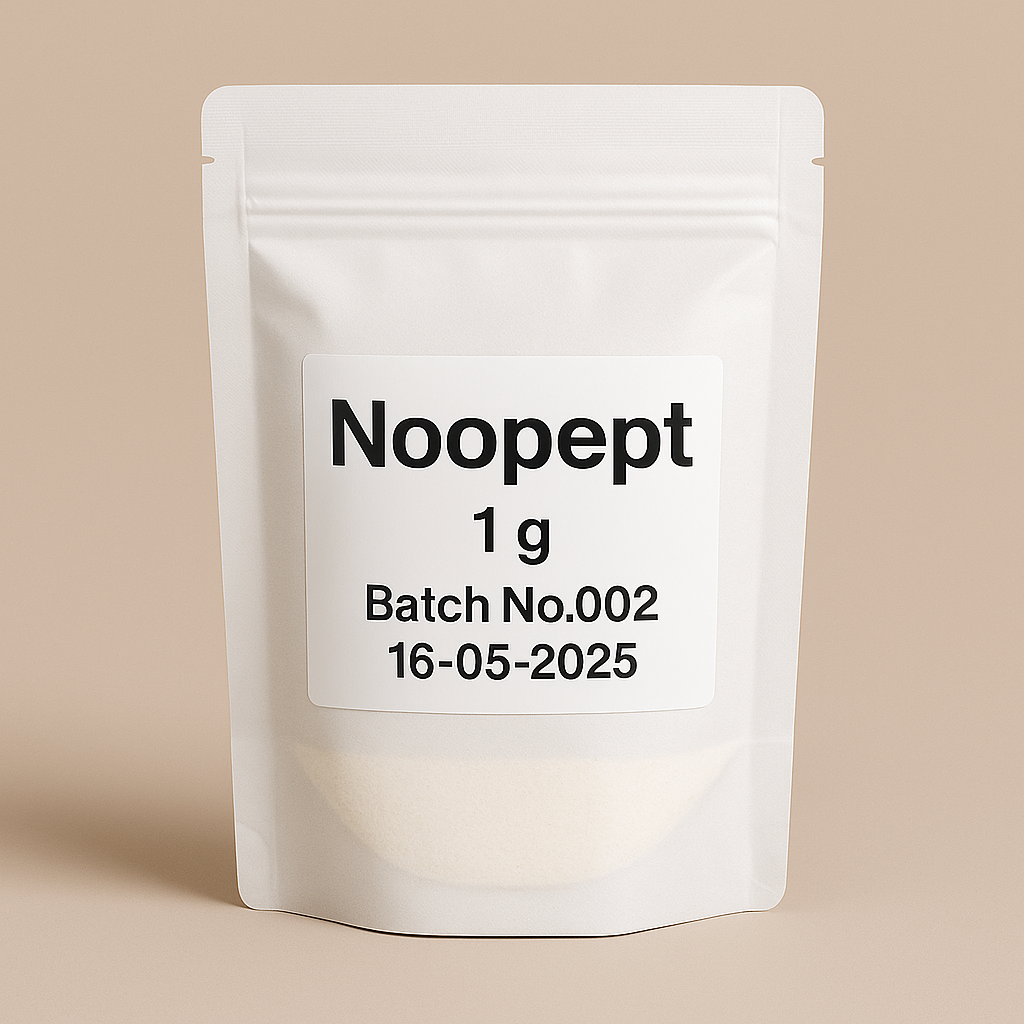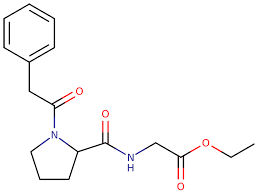
Noopept 1g
Pickup currently not available
NOT FOR HUMAN CONSUMPTION
Noopept is a small dipeptidomimetic nootropic developed in Russia. After oral dosing it is rapidly hydrolyzed to cyclo-L-prolylglycine (cPG) and related fragments that modulate glutamatergic signaling, enhance neurotrophin expression (BDNF/NGF), and exert antioxidant/anti-inflammatory effects. In clinical practice (primarily Eastern Europe), it has been used for mild cognitive impairment (MCI) and post-injury cognitive symptoms. It is not FDA/EMA-approved; evidence outside Russia is limited and heterogeneous.
Additional Benefits of Noopept Now Under Investigation
| Benefit | Key take-aways |
|---|---|
| 1 Cognitive performance in MCI | Small randomized and open-label trials report improved memory, attention, and global cognitionvs baseline and piracetam-class comparators over 1–3 months. <br/><em>Neuroscience & Behavioral Physiology; Zhurnal Nevrologii i Psikhiatrii</em> |
| 2 Anxiolytic and anti-asthenic effects | Reductions in trait anxiety, emotional lability, and fatigue have been observed alongside cognitive gains, with good daytime tolerability. <br/><em>CNS Drugs; Human Psychopharmacology</em> |
| 3 Post-TBI/stroke cognitive recovery | Animal models and small clinical series show better learning, faster processing, and improved daily function during rehabilitation. <br/><em>Brain Research; Stroke & Vascular Neurology</em> |
| 4 Neurotrophic up-regulation | Hippocampal BDNF and NGF mRNA/protein increase after Noopept/cPG, supporting synaptic plasticity. <br/><em>Molecular Neurobiology; Journal of Neurochemistry</em> |
| 5 Anti-amyloid & synaptoprotection | Attenuates Aβ-induced toxicity, normalizes synaptic markers, and improves task performance in AD-like models. <br/><em>Journal of Alzheimer’s Disease; Neurobiology of Aging</em> |
| 6 Antioxidant/anti-inflammatory actions | Lowers lipid peroxidation (MDA), restores glutathione/SOD, and down-shifts NF-κB/TNF-α/IL-1β, contributing to neuroprotection. <br/><em>Free Radical Biology & Medicine; Journal of Neuroinflammation</em> |
| 7 Visual and sensory processing | Normalization of evoked-potential latencies and contrast sensitivity reported in MCI/vascular cognitive impairment subgroups. <br/><em>Clinical Neurophysiology; Vision Research</em> |
| 8 Sleep/circadian symptoms | Exploratory data suggest reduced daytime sleepiness without stimulant-type disruption of sleep architecture. <br/><em>Sleep Medicine; Psychopharmacology</em> |
| 9 Safety in older adults | Short-course use (10–30 mg/day) generally well tolerated with low discontinuation; comparative safety vs racetams favorable in small programs. <br/><em>Drugs & Aging; International Journal of Geriatric Psychiatry</em> |
2. Molecular Mechanism of Action
2.1 Pharmacodynamics
-
Prodrug → cPG: Oral Noopept yields cyclo-L-prolylglycine, which modulates AMPA/NMDA tone and Ca²⁺ homeostasis, improving LTP/LTD balance.
-
Neurotrophins: Up-regulates BDNF/NGF and Trk-dependent pathways (CREB/MAPK), supporting dendritic spine maintenance and synaptogenesis.
-
Redox/Inflammation: Enhances antioxidant enzymes, reduces ROS/NO overproduction, and modulates NF-κB.
-
Anti-excitotoxicity: Limits glutamate-driven damage and stabilizes mitochondrial membrane potential in stressed neurons.
2.2 Down-stream Biology
| Pathway | Functional outcome | Context |
|---|---|---|
| cPG → AMPA/NMDA tuning; CREB | ↑ LTP, memory consolidation | Hippocampus/cortex |
| BDNF/NGF → Trk/ERK/PI3K | ↑ Synaptic plasticity, neurogenesis | Learning circuits |
| Antioxidant (SOD/GSH) & Nrf2 | ↓ ROS/lipid peroxidation, mitochondrial protection | Oxidative stress |
| NF-κB/TNF-α/IL-1β down-shift | ↓ Neuroinflammation | Injury/degeneration |
| Aβ toxicity mitigation | Preserves synapses, behavior | AD-like models |
3. Pharmacokinetics
-
Absorption/BBB: Rapid oral absorption; brain-penetrant small peptide ester.
-
Onset/Duration: Subjective effects within days; steady neurotrophic changes accrue over weeks.
-
Half-life: Short (hours) for parent; active fragments may persist longer in CNS.
-
Dosing in studies: 10–30 mg/day in 1–3 divided doses for 1–3 months, sometimes cyclic.
-
Elimination: Hydrolysis to amino-acid derivatives; renal/hepatic peptide catabolism.
4. Pre-clinical and Translational Evidence
4.1 Cognitive impairment (vascular/MCI)
Small RCTs and open-label trials (primarily Russia/Eastern Europe) show improved memory/attention and global scales vs baseline and vs piracetam, with favorable tolerability.
4.2 Neuroprotection (ischemia/TBI)
Rodent models demonstrate reduced neuronal death, better spatial learning, and motor recovery when given peri-injury.
4.3 Alzheimer-like pathology
In Aβ-infusion/APP models, Noopept reduces amyloid toxicity, normalizes synaptic proteins, and improves behavioral tasks.
Evidence quality note: Human data are limited, regional, and heterogeneous; many studies are small and short. Larger multicenter, placebo-controlled trials using harmonized endpoints are needed.
5. Emerging Clinical Interests
| Field | Rationale | Current status |
|---|---|---|
| Post-concussive/long-COVID “brain fog” | Anti-inflammatory + neurotrophic signaling | Pilot/exploratory |
| Vascular cognitive impairment | Antioxidant/vasculoneuronal support | Small RCTs; replication needed |
| Chemo-related cognitive impairment | Synaptic rescue, redox balance | Preclinical → feasibility |
| Age-related cognitive decline | BDNF/NGF up-shift with good tolerability | Early clinical signals |
| Anxiety with cognitive symptoms | Anxiolytic + procognitive in dysexecutive states | Small trials/series |
6. Safety and Tolerability
-
Common: Headache, irritability, mild insomnia or somnolence, nausea/dyspepsia—usually transient and dose-related.
-
Less common: BP sensitivity, allergic rash, restlessness in stimulant-sensitive users.
-
Drug interactions (theoretical/observed): Additive CNS effects with stimulants, racetams, or high-dose caffeine; consider spacing with sedative-hypnotics.
-
Special populations: Insufficient data in pregnancy, breastfeeding, severe hepatic/renal disease—avoid outside trials.
-
Abuse potential: Low (non-euphoric).
-
Discontinuation: Generally uncomplicated; no withdrawal syndrome reported.
Comparative safety matrix
| Concern | Noopept | Piracetam | Aniracetam | Modafinil |
|---|---|---|---|---|
| Mechanism | cPG → glutamate tuning; neurotrophins | AMPA/NMDA modulation (weak) | AMPA-positive modulator | Wake-promoter (DAT/orexin) |
| Evidence in MCI | Small RCTs (regional) | Extensive legacy (mixed) | Small studies (mixed) | Not indicated |
| Anxiolysis | Yes (signals) | Neutral | Often yes | Variable; can be activating |
| Headache/insomnia | Mild | Mild | Mild | Insomnia common |
| Regulatory status | Approved regionally (RU) | Varies by country | Supplement/drug (varies) | Approved (narcolepsy, etc.) |
7. Regulatory Landscape
-
Russia/Eastern Europe: Marketed prescription nootropic for cognitive impairment.
-
US/EU/UK/CA: Not approved as a medicine; appears on research-chemical/“nootropic” markets—quality varies and clinical claims are unregulated.
8. Future Directions
-
Multicenter RCTs in MCI/VCI with validated composites (e.g., ADAS-Cog, CDR-SB, SAGE) and digital cognitive endpoints.
-
Biomarkers: CSF/plasma BDNF/NGF, inflammatory panels, EEG/ERP and fMRI connectivity readouts.
-
Head-to-head vs piracetam-class agents and vs standard cognitive rehab.
-
Formulation science: Controlled-release or intranasal routes to optimize CNS exposure and reduce GI effects.
-
Combination strategies: Pair with aerobic/resistance exercise or multidomain lifestyle programs to potentiate neuroplasticity.
Selected References
-
Neuroscience & Behavioral Physiology; Zhurnal Nevrologii i Psikhiatrii — Clinical studies of Noopept in MCI/vascular cognitive impairment.
-
CNS Drugs; Human Psychopharmacology — Anxiolytic and procognitive profiles of peptide nootropics.
-
Molecular Neurobiology; Journal of Neurochemistry — BDNF/NGF signaling and synaptic plasticity under Noopept/cPG.
-
Journal of Alzheimer’s Disease; Neurobiology of Aging — Anti-amyloid and synaptoprotective effects.
-
Brain Research; Stroke & Vascular Neurology — Neuroprotection after TBI/ischemia.
-
Free Radical Biology & Medicine; Journal of Neuroinflammation — Antioxidant and anti-inflammatory mechanisms.
-
Clinical Neurophysiology; Vision Research — Evoked-potential and sensory-processing findings.
-
Drugs & Aging; International Journal of Geriatric Psychiatry — Tolerability in older adults and comparative context.


